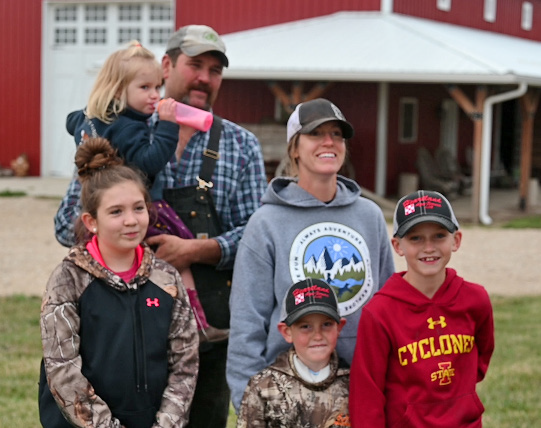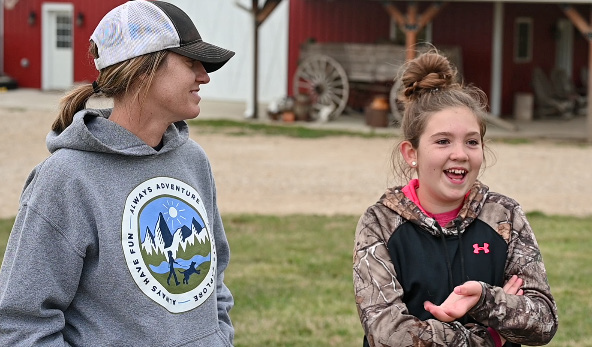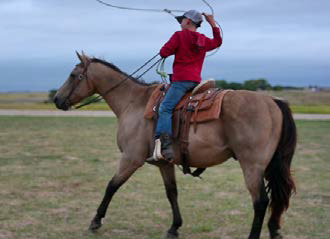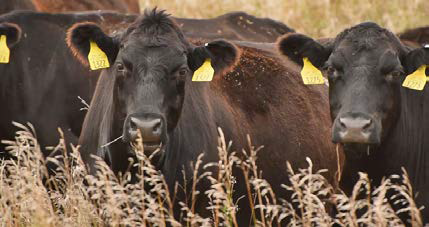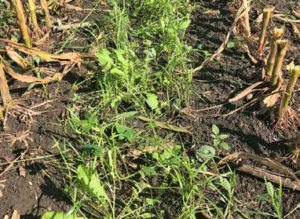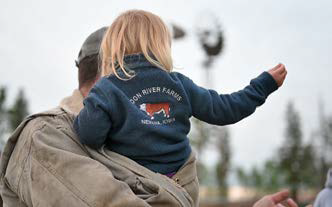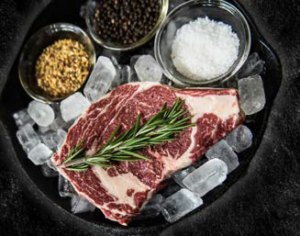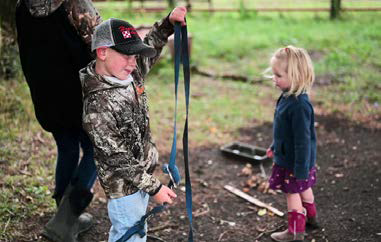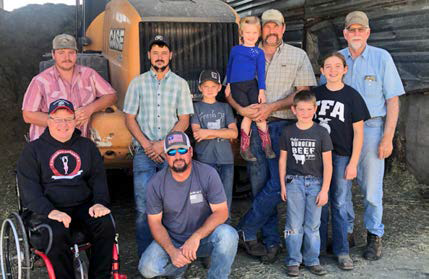Farming for the Future
In 2001, when Seth Smith was a junior studying ag systems technology at Iowa State University, he purchased a farm neighboring his family’s land in Nemaha, Iowa. It was the early 2000s, and the agricultural economy was in a rut, with corn below $2 per bushel and soybeans below $4 per bushel.
The first year Seth raised a crop on the farm, he lost money. It was the first crop he’d raised on his own, and Seth knew that if he was going be financially viable while farming alongside his father, he would need to alter some practices on the conventional grain and cattle-finishing farm.
“Dad let me know that nothing was going to be given to me,” Seth says. “I needed to make my own way.”
Around the same time Seth returned to northwest Iowa, Etta Simpson had moved to the area from Delaware for her career as a U.S. Department of Agriculture meat inspector in Storm Lake, Iowa. She purchased an acreage located a couple of miles from Seth’s house.
Etta’s dog wandered off one summer day and wound up at Seth’s farmstead. He called the number on the dog’s tag and left a message. A few hours later, Etta came to retrieve the dog and the two hit it off.
Seth and Etta got married in 2008 and have four children: Skylar (12), Lane (9), Levi (7) and Tilly (3). The family, along with Seth’s father, Lynn, his grandfather, Bill, and three full-time employees, operates SFI Inc. and Coon River Farms Inc. – named after the Raccoon River that runs adjacent to much of their land.
In the last 20 years, Seth and Etta have collaborated with Lynn to make changes to the farm to increase profitability and expand the operation while reducing labor demands. Today, the diversified farm has grown to consist of a 2,400-head-capacity beef-finishing feedlot; a 280-head cow-calf herd; organic corn, soybeans, oats and alfalfa in a five-year rotation; conventional corn silage with cover crops; and reclaimed pasture. In addition to farming, the Smiths own and operate Coon River Gate Company, which builds and sells portable cattle gates.
Adding Organic Row Crops to Boost Farm Revenue
The path to this diversified operation has its roots in Seth’s first year farming on his recently purchased farm. After losing money raising conventional corn and soybeans that year, Seth looked for a more profitable enterprise.
“My only off-farm job growing up was on another farm – Dave Nees’ farm, which was organic. I had done some cutting and baling hay,” Seth says. “After that first year of losing money, I remember thinking, ‘organic prices are really high!’ So I talked to Dave a bit.”
Seth began the transition to organic production on a 160-acre field next to the family’s feedlot. A 50-acre portion of the field had been in alfalfa, so he applied manure and plowed the alfalfa under to plant corn the following year. The corn crop yielded well, and with organic corn prices over double the conventional corn prices, he found organic cropping to be profitable.
“I realized that you have to think hard, not just work hard.”- Seth Smith
Seth notes that raising organic row crops is significantly more labor-intensive than conventional row crops. “You spend a lot of time controlling weeds,” Seth says.
Seeking ways to reduce that labor, for the last 20 years Seth and Lynn have been experimenting with more time-saving organic weed control methods. They were early adopters of a sub-inch-accuracy GPS system that enables higher speeds while tine weeding and harrowing. Seth also built a custom weed flamer. The machine uses propane to throw a flame on weeds, damaging the cell structure, either killing the weed or reducing growth.
The last few years, they have been experimenting with roller-crimping cereal rye in organic soybeans. Crimping the rye flattens it into a dense mulch, which physically suppresses weeds and eliminates the need for in-season cultivation. “Long-term, we’d like to have all of our soybeans in no-till, organic,” Seth says.
The Smiths’ continuous innovation is a quality that makes the family a respected leader among organic farmers and conventional farmers alike.
Past Labor Limitations Spur Other Changes
Growing up, Seth recalls observing a neighbor whom Seth describes as “one of the hardest workers I know.” The neighbor put in long hours and was expanding the operation to try to eke out an additional profit, but eventually decided to sell the farm and work an off-farm job. Seeing the neighbor work long hours without making much money prompted Seth to look at his own work hours, and whether they were generating revenue or saving costs.
“I realized that you have to think hard, not just work hard,” Seth explains. “When I had just come back home to start farming, there were three of us – my dad, the hired hand and me – all working seemingly endless hours, spinning our wheels constantly.”
In 2002, the Smiths began composting feedlot manure and corn stalk bedding as a way to save time. Composting requires some additional upfront labor, but the process reduces the manure’s moisture content and total tonnage and means the Smiths spend less time hauling manure. “We didn’t even know of the other benefits of compost at the time,” Seth says.
They also paved what had been dirt feedlots, reducing the number of hours spent doing “dirt work” in the lots and the quantity of dirt in the manure. Beyond saving time, Seth reports the feedlot cattle perform better on concrete.
Reducing daily labor demands has enabled the Smiths to increase the number of acres they farm and the amount of beef they produce.
In his part of rural Iowa, Seth says reducing labor doesn’t just save money, it’s a necessity. “When you’re in a human desert like Sac County, it is really hard to find people to work. We’ll post ads in multiple places and have just a couple people apply.”
Tracking the financial success of those changes is where Etta comes in. As the farm’s record-keeper, a task she manages in addition to her off-farm job as a meat inspector, she keeps track of the expenses and revenue from all the family’s enterprises, which the Smiths use to make decisions. Though Etta downplays her role – “I just feed the kids and make sure they go to church,” she jokingly says – Seth says her work managing finances from the farm’s many enterprises and experiments is especially important.
“When it’s time to make a decision on the farm, Etta knows the exact costs and revenue of different processes,” Seth says. “It is easy to get caught up in the daily work and not see the bigger picture. Etta’s records keep us thinking about the future.”
Ridge-Till, Research Bring the Smiths to PFI
The family’s ongoing willingness to experiment with new practices has a long history – and has linked the Smiths with PFI for two generations. In the 1980s, Lynn joined PFI around the time PFI co-founder Dick Thompson was pioneering ridge-till. A ridge-tiller himself, Lynn joined to learn more from Dick and other members.
The Smiths’ involvement in PFI was sparked again when Seth struck up a conversation with PFI member Paul Mugge, an organic farmer from Sutherland, Iowa, at the Iowa Organic Association conference.
“Paul was talking about all the organic trials that PFI members were doing on-farm,” Seth says. “I figured I might as well join to see the research and weed out ideas that someone else has already trialed on their farm.”
Since joining PFI, Seth has been conducting trials on the grazing value of cover crops through the Cooperators’ Program. He values the accountability that comes with participating in the program. “I’ve been doing informal trials and some record-keeping on my farm for as long as I can remember, but I don’t always do the best job of doing anything with those records,” he says. “Having someone to answer to made keeping detailed records a priority.”
Researching the Value of Grazing Cover Crops
About 15 years ago, Lynn and Seth observed some spring wind erosion on corn silage ground that unsettled them. The following autumn, they seeded oats with a fertilizer spreader and used a rotary hoe to incorporate the seed.
“It rained and rained that fall, and the oats got probably 18 inches tall,” Seth says. “I remember thinking, ‘Man, we should put something out there to eat those!’ We didn’t have cows at that point.” Cows came to Coon River Farms the following year. Now, the Smiths interseed annual rye, turnips, rapeseed, vetch, cowpeas and clover into 38-inch corn, or they drill cereal rye after silage harvest.
Curious to quantify more precisely the forage value of cover crops on the farm, Seth has been keeping grazing records since 2019 as part of an on-farm research project through PFI.
Seth kept records on grazing bulls and cow-calf pairs, and he found that he saved $84 per acre, or $3.13 per animal unit per day, by grazing both sets of cattle on cover crops instead of feeding hay. Analyzing Seth’s data, PFI’s livestock programs manager, Meghan Filbert, calculated that the Smiths saved $31,550 in hay expenses by grazing the cereal rye cover crop.
Full details of his findings are summarized in the research report “Economic and Soil Health Impact of Grazing Cover Crops in Cow-Calf Operations,” available here.
“We’re starting to see better soil health, better water holding capacity and healthier plants. I’m attributing that to soil health of the no-till and cover crops with cows in the picture.” – Seth Smith
Reflecting on the results, Seth says, “We can grow cow feed [cover crops] a heck of a lot cheaper than we can chop silage or buy hay. Now our winter feed is the cheapest point of feed in the year.” Beyond the forage value, Seth adds that grazing cover crops can reduce labor and is contributing to healthier soil and plants.
“A lot of years, we can go three months without hauling any feed while the cows are in a field,” he says. “We’re starting to see better soil health, better water holding capacity and healthier plants. I’m attributing that to soil health of the no-till and cover crops with cows in the picture.”
Raising Cattle Runs in the Family
Something Seth did not change upon returning to the farm is finishing beef cattle – the family has been doing so for over 70 years. “We had the facilities, and we had the know-how. So expanding that was an easy way for me to join the operation versus starting something from scratch,” Seth says. “Plus, I have several generations of expertise to call on.”
The Smiths own their cattle, but Sac County has a high concentration of farmers who raise cattle, poultry and pigs on contract – an arrangement where those farmers agree to raise livestock owned by someone else. Seth says that when his father got started farming, contract feeding didn’t exist. “You either owned the livestock, or you didn’t have any. Now the bulk of livestock in this county is owned by someone else.”
The Smiths have opted to maintain ownership of their cattle because they think it’s more profitable than raising contracted livestock. But they’ve also found that the consolidated beef industry in the U.S. is vulnerable to disruption. Seth explains that the majority of cattle in the region are sold to meatpackers through pre-arranged production contracts, which commit farmers to sell their animals to the company they’ve contracted with when the animals reach a certain size or weight.
Meatpackers are likewise obliged to fulfill the terms of these contracts, even when a market or supply chain disturbance occurs. Rather than turning to independent, non-contracting livestock farmers to fill in during any supply gaps, the packing companies must work through their contract backlog. The fragility of the nation’s meat supply chain was further revealed when meatpacking plants shut down in 2020 as COVID-19 cases surged in Iowa and nationally.
One way the Smiths are working around the constraints of a consolidated beef-packing industry is by direct-marketing their beef locally.
Direct Markets Build Community
Etta and Seth began direct-marketing some of their cattle in 2014. Today, if you pick up an issue of the local Storm Lake Times newspaper, you are likely to see an advertisement for Coon River Farms beef. The cattle are processed in the nearby towns of Holstein or Ruthven, which means jobs stay local.
“Direct-marketing is a small portion of where our cattle go, but we love it,” Etta says. She adds, “It seems since COVID-19, people are more aware of our food system flaws. I believe more people find satisfaction in buying off the farm and using local lockers, keeping their dollars in the community.”
Etta sees direct-marketing as a way to engage with people who are not as involved in agriculture, and for the community to become more aware about where their food comes from and how it’s raised.
“ I believe more people find satisfaction in buying off the farm and using local lockers, keeping their dollars in the community.” – Etta Smith
“It connects people to their food. They get interested in how that animal was raised, all the way through how it was processed,” she says. “They know they can drive by our place and see where their beef is being produced. It’s also very rewarding as a producer to get that phone call from a customer saying they just ate the best steak of their life.”
Skylar, Etta and Seth’s eldest daughter, also runs a direct-market egg and broiler chicken business. In 2015, at age 6, she started her egg business, which she continues to run, and has had a broiler business since 2019. In 2021, she raised 150 broilers on pasture, moving them every couple of days.
The experience is teaching her about what’s involved with managing and marketing such an enterprise – and how to find ways to improve it.
“Skylar has always been an entrepreneur and has paid her own way through every step of her business,” Etta says. “She orders her own feed to be delivered to the bulk bin, and she writes the checks from her account for all expenses. She understands break-evens and how that determines what she charges for her products.”
Reinvesting in Rural and the Next Generation
For the Smiths, supporting the local community isn’t just part of their farm’s economic strategy. It’s equally about investing in the community’s future vitality. Lynn recalls how, decades ago when he started farming, his rural neighborhood was filled with farmsteads. “When I first started farming, there were four families in a section,” he says. ‘Now, we’re lucky if there is one family in a section.”
Farms like the Smiths’ are countering this trend, however. To help run Coon River Farms’ diverse and labor-intensive enterprises, the family employs three people full-time in addition to Seth, Etta and Lynn. Those employees all live within 8 miles of the farm, which further benefits the local economy. “The guys that work for us are phenomenal,” Seth says. “They can really run some of the operation on their own, which lets me think about the bigger picture and where the farm will be in 20, 30 years.”
The Smith family is also committed to sharing agriculture with the local youth. Etta sees her children as ambassadors of agriculture who are helping to educate the next generation of consumers. “There are few farm kids that go to school with our kids,” Etta says.
“Since our children are involved in the daily farming operation, they go to school and educate their peers just through conversations. I’ve found that even though kids and adults are more distant from the farm than ever, they are still very interested. They want to know about the lifestyle and what we do.”
“It’s important for our generation to engage with the next generation because we need more farmers,” she adds. “Telling our story could inspire a young person in one way or another, and younger generations can learn from our mistakes and from our experience.”


